When you enter the kitchen, you can smell your mother's hot baking cookies.
After staying for some time in the kitchen, you may notice that you cannot
smell the cookies anymore.
The nose has 'olfactory receptors' (smell detectors) in the nasal mucosa on
the roof of the nose. When an odour molecule dissolves in the mucosal fluid,
it stimulates the olfactory receptors which send signals to the brain.
Your brain interprets the type of smell you are experiencing.
Olfactory receptors are so sensitive that as few as eight odour molecules
dissolved in the mucosal fluid can trigger them.
Humans can detect some thousands of smells. But, this is nothing when
compared to the olfactory sensitivity of a dog. Your dog can detect millions of
smells!
The olfactory receptors are 'phasic’ or ‘dynamic’ receptors. This means that
when they continue to detect the same smell continuously, they decrease the
signals which they send to the brain. After a while, they slowly stop sending
signals about that smell to the brain.
This is why we stop smelling the same odor after a while.
When we move away from the source of that smell, the olfactory receptors
slowly regain their sensitivity to the odour for the next time you encounter it.
©
Copyright 2009 All rights reserved
- 29 -
http://www.pathology-world.com/
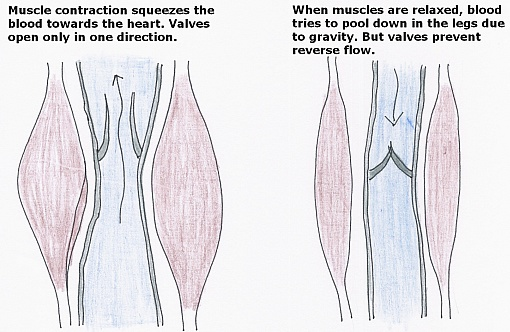
"101 Facts About the Human Body" by Radhika Venkata
Page 30 of 107
Blood and Circulation
Why should we avoid sitting too long?
The human body is designed to be upright and active. We stand on our legs
and move around.
When we stand, the pressure in the blood vessels in the lower body is higher
than that in the blood vessels near our heart. Since the blood can't move
from higher pressure to lower pressure, we need some mechanism that
pushes the blood towards the heart.
Venous system of the leg – Some call it a 'SECOND HEART'.
There is a pumping system in our legs. It is provided by our leg muscles
which squeeze the deep veins between them when we walk or run, and that
causes the blood to be pushed up toward the heart.
Our veins have flaps, called 'valves' that stop the blood flowing backwards
after the muscles relax. These valves close when the muscles relax and that
stops our blood pooling in the lower legs.
When we sit for long hours, this pumping mechanism does not operate and
we feel heaviness in the legs. This can cause blood pooling and damage to
valves. People who sit for long hours should take regular breaks and move
©
Copyright 2009 All rights reserved
- 30 -
http://www.pathology-world.com/
"101 Facts About the Human Body" by Radhika Venkata
Page 31 of 107
about for at least a few minutes each time.
Why do you sometimes feel dizzy when you get up?
If you are lying down and get up suddenly, you may feel dizzy or light-
headed for a few seconds. This is called ‘postural’ or ‘orthostatic’
hypotension.
It is caused by low blood pressure. Our blood vessels usually start to tighten
when we get up, to help maintain the supply of oxygen-rich blood to the
brain.
If we get up so suddenly that they do not tighten enough, less blood is
available to our brain and symptoms like mild dizziness or blurred vision may
happen.
This is common. But, if it occurs frequently, even when we get up more
slowly, then we should consult our doctor because it may be a symptom of a
treatable condition such as loss of fluids from the body, fever or heart
problems.
What are the Odd Artery and the Odd Vein in our
bodies?
Put your left hand on a table with palm facing up. Now, put your right index
and middle finger just above the wrist (1 or 11/2 inch above wrist line) a
little left to the center. Press lightly. Do you feel pulsations from an artery?
When your heart beats, it pumps blood in to arteries so whole body is
supplied with oxygen. All body tissues need oxygen to live.
©
Copyright 2009 All rights reserved
- 31 -
http://www.pathology-world.com/
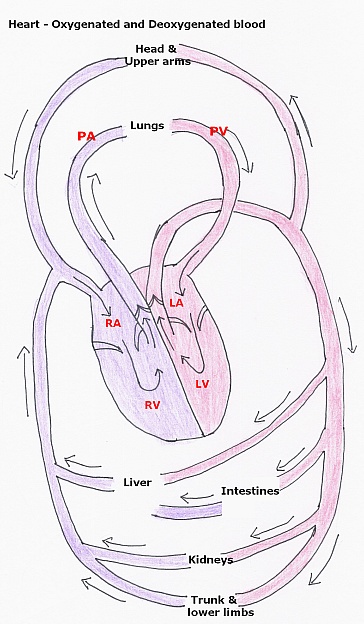
"101 Facts About the Human Body" by Radhika Venkata
Page 32 of 107
Circulation of blood:
Point #1: All arteries carry oxygenated blood and are shown in red. All
veins carry deoxygenated blood and are represented by blue.
Point #2: Arteries ALWAYS carry blood from heart to body and body organs.
Veins ALWAYS carry blood from body and body organs to heart.
Point #3: This is a simplified diagram. The arteries and veins in the body are
NOT separated left and right side. In most cases each artery is accompanied
by a related vein. e.g.: The artery which carries blood to the liver is called
©
Copyright 2009 All rights reserved
- 32 -
http://www.pathology-world.com/
"101 Facts About the Human Body" by Radhika Venkata
Page 33 of 107
the 'hepatic artery'. It is accompanied by a 'hepatic vein' which carries blood
towards the heart.
Point #4: The direction of the arrows shows the blood flow.
In the image, PA represents the pulmonary artery. It is supposed to carry
oxygenated blood as it is an artery, but it carries de-oxygenated blood to the
lungs to get oxygen from the lungs.
PV means pulmonary vein. It is supposed to carry deoxygenated blood as it
is a vein, but it carries oxygenated blood to the heart.
Circulation: Oxygenated blood goes from left ventricle (LV) to the body and
organs. The body uses oxygen and gives off carbon dioxide into the blood.
This deoxygenated blood flows back to the right atrium (RA) and then to
right ventricle (RV).
It goes from there to the lungs to get rid of the carbon dioxide and get
oxygen.
Then, it travels from the lungs to the left atrium (LA) and to the left ventricle
(LV).
Then, the cycle repeats.
An Artery is a blood vessel that carries blood from the heart to the body
organs. Arteries carry 'oxygenated blood' (blood rich in oxygen). Your tissues need plenty of oxygen.
But, Yes - there is an odd artery!
It is called the 'pulmonary artery'. Though it is an artery and carries blood
from the heart to the lungs, it carries poorly-oxygenated blood.
Once the artery supplies oxygen to tissue, the blood becomes less
oxygenated. The de-oxygenated blood then travels through small vessels,
called venules, in the tissues. The venules slowly merge to become veins
which carry to blood back to the heart.
A Vein is a blood vessel that carries 'de-oxygenated blood' from body tissues
(that used up the oxygen) to the heart. .
What is this odd vein?
©
Copyright 2009 All rights reserved
- 33 -
http://www.pathology-world.com/
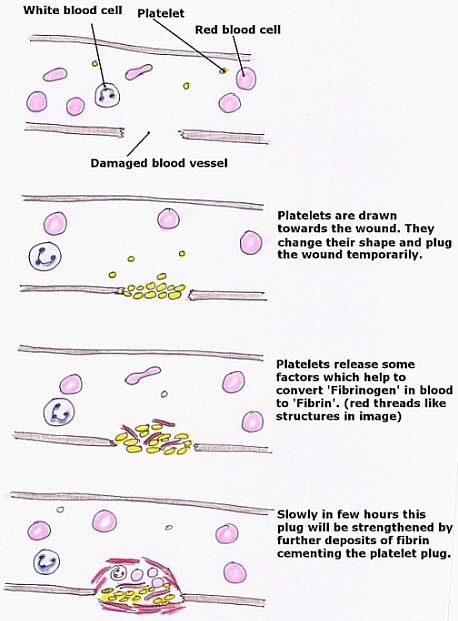
"101 Facts About the Human Body" by Radhika Venkata
Page 34 of 107
It is called 'Pulmonary vein'. It carries blood from the lungs to the heart but,
unlike other veins, it carries blood that is rich with oxygen.
How does our body stop bleeding from a cut?
If there was no protective mechanism to stop the bleeding, we would bleed
continuously from any cut to our skin. When there is a cut, blood pours out
from the blood vessels under the skin.
Blood clotting near the damaged blood vessel.
There are tiny cells called 'platelets' in the blood. The platelets clump
©
Copyright 2009 All rights reserved
- 34 -
http://www.pathology-world.com/
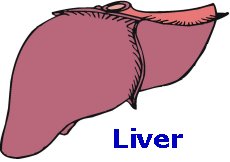
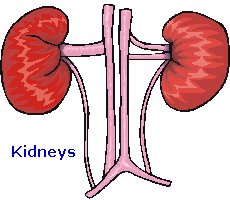
"101 Facts About the Human Body" by Radhika Venkata
Page 35 of 107
together when they are exposed to air in the cut, forming a loose plug.
Some chemical substances from the damaged tissue change a blood protein
called ‘prothrombin' to an enzyme called 'thrombin'. The thrombin, in turn,
changes a protein called 'fibrinogen' to 'fibrin', which forms a strong plug
over the leaking blood cells.
Did you know that you need Vitamin K and calcium for the blood to clot
properly?
Keep your supply of these essentials at proper levels by eating green, leafy
vegetables like spinach and broccoli as well as liver and cereals. For calcium,
drink milk regularly!
Which organs in our body get the most blood?
BLOOD SUPPLY PER MINUTE:
Liver: 1500 ml per minute.
The liver is the organ with the
highest blood flow per minute.
It is around 1500 ml/min. (Ref.
Ganong) The peculiarity of the
blood supply to the liver is that
2/3 of the blood is venous blood
and it is from the digestive tract
(stomach, intestine, colon,
spleen). The remaining 1/3 is arterial blood from the hepatic artery.
The liver participates in important body functions like storage, synthesis,
modifying harmful substances to less harmful ones and cholesterol
metabolism.
BLOOD SUPPLY BY WEIGHT:
Kidney: 420 ml per 100 gm
weight per minute.
If we take the weight of the
organ into consideration, the
©
Copyright 2009 All rights reserved
- 35 -
http://www.pathology-world.com/
"101 Facts About the Human Body" by Radhika Venkata
Page 36 of 107
kidney receives more blood than the liver. The kidney is the organ which
filters blood and absorbs vital substances from the filtered fluid and forms
urine. Urine contains nitrogenous waste that needs to be eliminated from the
body.
Whole blood in our body passes through the kidneys once within every 5
minutes to ensure that the blood is clear of nitrogenous wastes.
Why does your heart beat faster when you run?
When you run, your body needs more oxygen and energy, especially the leg
muscles. The heart has to pump faster to satisfy this increased demand.
During running, hormones called epinephrine and norepinephrine are
released from a gland called the 'adrenal gland' in our body. These hormones
increase our heart rate and the strength of its contractions.
When you finish running, the heart rate of a healthy person should return to
normal with just a few minutes of rest.
Why is Blood red in Color?
Our blood contains many cells; red blood cells, white blood cells and
platelets.
The red blood cells are dumb-bell shaped when looked at from the side and
look like discs from the front. There are millions of them in each drop of
blood.
©
Copyright 2009 All rights reserved
- 36 -
http://www.pathology-world.com/
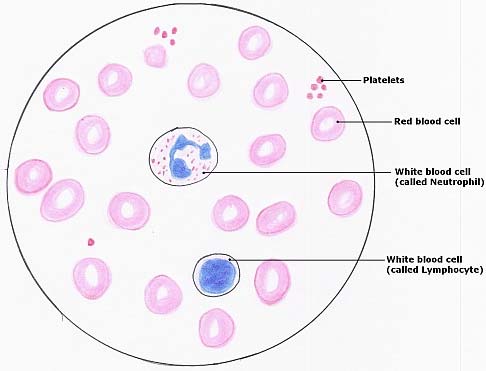
"101 Facts About the Human Body" by Radhika Venkata
Page 37 of 107
The red blood cells contain a protein called 'hemoglobin'. This hemoglobin is
a combination of 'Heme', which binds oxygen to it and a 'globin chain' which
is the protein part of the hemoglobin.
Hemoglobin contains elemental iron in the center.
The hemoglobin helps to carry oxygen from your lungs to the your body
tissue and then carry the carbon dioxide back from the tissue to your lungs
so that it can be breathed out.
When blood goes to your lungs and gets oxygen, it becomes bright red. You
will see this bright red blood in arteries. Once the blood gives the oxygen to
the tissues and takes back the carbon dioxide, it becomes dark red or bluish.
You will see this dark red or bluish-red blood in veins.
What do I need to know about Hemoglobin?
The normal hemoglobin content in blood is about 16 grams per deciliter in
men and about 14 grams per deciliter in women.
16 grams is about .56 (a little over half) of an ounce.
14 grams is about .49 (just under half) of an ounce.
A decilitre is about 3.4 (just under three and a half) fluid ounces.
©
Copyright 2009 All rights reserved
- 37 -
http://www.pathology-world.com/
"101 Facts About the Human Body" by Radhika Venkata
Page 38 of 107
0.3 grams of old Hemoglobin is destroyed and 0.3 grams of new hemoglobin
is synthesized (produced) every hour.
Each red blood cell has 97% of hemoglobin by dry weight.
Hemoglobin synthesis is very important and it relies on you eating food which
contains iron. Meat, green vegetables and enriched cereals are rich sources
of iron. You should get enough of the right foods every day to ensure the iron
you need for making hemoglobin.
People are likely to get 'anemia' when the level of hemoglobin decreases in
their blood.
Who are the universal donors
and universal recipients?
Doctors test blood types before giving blood from the blood banks to
patients. They do this to prevent any incompatibility reactions in patients
because these may cause death.
There are 4 blood groups:
1) A
2) B
3) AB
4) O
The blood group names are based on the 'antigen' present on the red blood
cell. If a person has an 'A' antigen on their red blood cell surface, he belongs
to the 'A' blood group.
Like the antigen is on the red blood cells, antibodies are present in the liquid
part of the blood (called 'plasma'). These antibodies are different to the
antigens. If a person is in 'A' blood group, he has 'b' antibodies in his plasma.
©
Copyright 2009 All rights reserved
- 38 -
http://www.pathology-world.com/
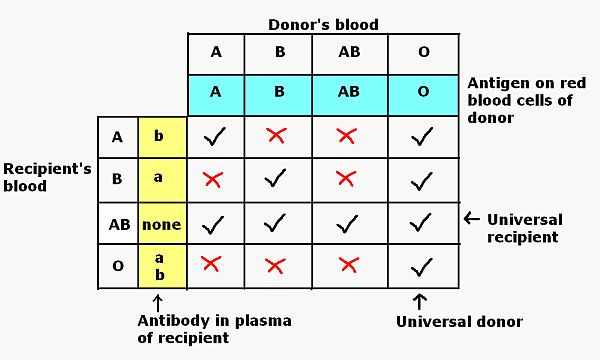
"101 Facts About the Human Body" by Radhika Venkata
Page 39 of 107
During a transfusion, the donor’s antigen on his red cells reacts with the
antibody present in the patient’s plasma. If the donor has blood group A
(which has antigen A) and their blood is given to a person with blood group B
(who has antibody 'a' in their plasma), the red cells of donor and the
antibody of the recipient will stick together and cause an allergic reaction.
The picture shows you that a person with blood group O is a universal donor.
He can give blood to anybody because he has no antigen.
Someone with blood group AB is a Universal Recipient; they can receive
blood from any donor because he has no antibodies to react with the
antigens of the donor’s red cells.
Why do we feel 'pins and needles' are in our arms
and legs?
When you have been sitting on a couch with your both feet up for a long
time, maybe watching TV, you might feel some prickly sensations in your
feet. Or, perhaps you have fallen asleep while sitting at your computer and
your head fell onto your hand and pressed it against the desk. Then, you got
that same feeling in your hands. We call this sensation, ‘pins and needles’.
It results from the blood vessels in your feet or hands being unable to get
©
Copyright 2009 All rights reserved
- 39 -
http://www.pathology-world.com/
"101 Facts About the Human Body" by Radhika Venkata
Page 40 of 107
sufficient oxygen because of the abnormal position of your limbs.
Your head pressing against your hand reduces the flow of blood through the
blood vessels there.
When you legs are raised and unmoving for a long period, less blood reaches
your feet and so they get less oxygen for the cells in them.
These positions also cause pressure on nerves in those areas and, when they
cannot transmit their impulses properly, you get the feeling of pins and
needles.
When you take off the pressure on your blood vessels or nerves, that pins
and needles feeling will slowly go away.
©
Copyright 2009 All rights reserved
- 40 -
http://www.pathology-world.com/
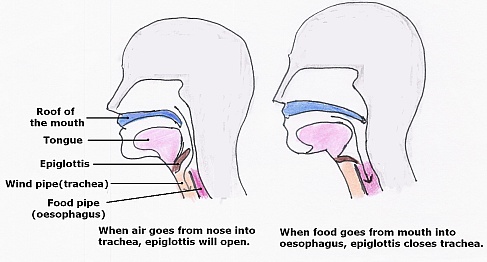
"101 Facts About the Human Body" by Radhika Venkata
Page 41 of 107
Breathing and Related Topics
Why can't people breathe and swallow at the same
time?
Food travels from the mouth food into the food pipe on its journey to our
stomach.
Air that we breathe in goes from our nose goes into the wind pipe on its way
to our lungs.
Both pipes are next to each other in the neck. But the food won't go into the
wind pipe. Why?
First image: Breathing opens the epiglottis. Air goes into trachea
(wind pipe - brown colored tube)
Second image: Swallowing the food closes the epiglottis and food
goes into esophagus (food pipe - dark pink tube)
In the above picture, you will see the food pipe and the wind pipe next to
each other. And there is a thin membrane called 'epiglottis' which closes the
wind pipe when we swallow the food doesn't enter the wind pipe.
If a person is eating, talking and laughing at the same time, food can get
stuck in the trachea and make the person choke.
So kids, be careful while eating!
©
Copyright 2009 All rights reserved
- 41 -
http://www.pathology-world.com/
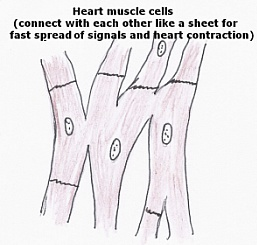
"101 Facts About the Human Body" by Radhika Venkata
Page 42 of 107
Cells
Are all cells in our body the same?
The cell is the basic building block of the body. A simple cell has some
common features:
A cell membrane
A nucleus
Cytoplasm (the contents of a cell, excluding the nucleus), mitochondria
(the part of the cell which generates energy for cell) and
Endoplasmic reticulum (a network of membranes where proteins are
produced).
All of the cells in all the organs in your body have this basic structure but
there are many different types of cells with special features that help them
do the special task which each particular type of cell does.
Heart muscle: The heart muscle is
made of 'cardiac muscle cells'. Each
cardiac muscle cell has fine lines called
striations in the cytoplasm (the part of the
cell outside of its nucleus).
The cells are connected with each other so
that the heart can smoothly contract as a
single unit.
Neuron: A neuron is a nerve cell. It has
a round cell body with many thin fibres projecting from it called dendrites.
These dendrites receive impulses from the other neurons.
Each neuron also has an elongated thick fiber called an 'axon'. The signal
received from dendrites is passed on to the next cell through the axon.
©
Copyright 2009 All rights reserved
- 42 -
http://www.pathology-world.com/
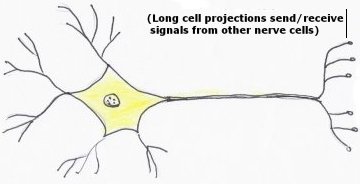
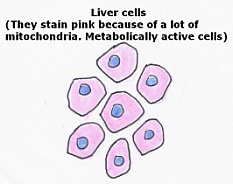
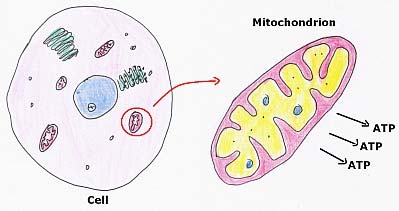
"101 Facts About the Human Body" by Radhika Venkata
Page 43 of 107
Liver cell: A Liver cell is a hexagonal (six-sided) cell with lots of
mitochondria (that part of the cell which generates energy for the cell) and
an endoplasmic reticulum (network of membranes where proteins are
produced).
These liver cells specialize in protein
synthesis, glycogen storage (your Liver
stores glucose as 'Glycogen'. If you miss a
meal, it slowly breaks down glycogen to
glucose and releases it into your blood),
producing bile from simple chemical
compounds (bile synthesis), storage of
Vitamin A and other vital substances, and converting toxic substances to less
toxic and soluble substances so they can be excreted from the body.
Which specialized part of a cell is called the
'Powerhouse”?
Our body is made up of millions of cells. These cells are the sam















